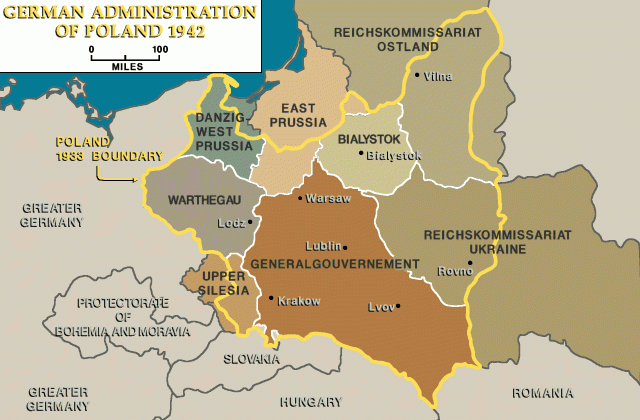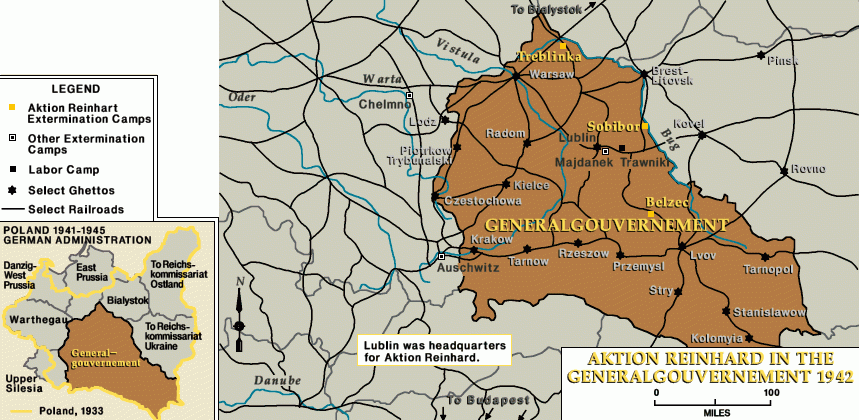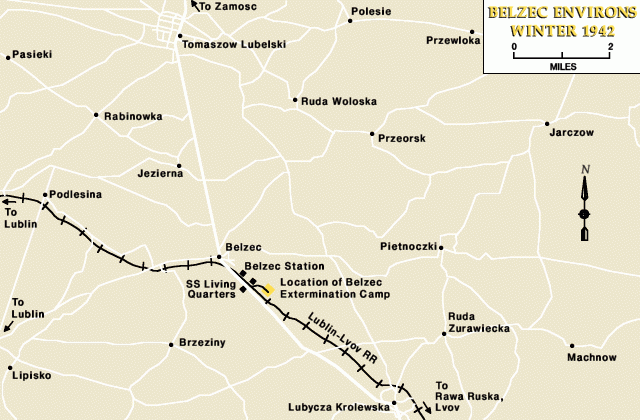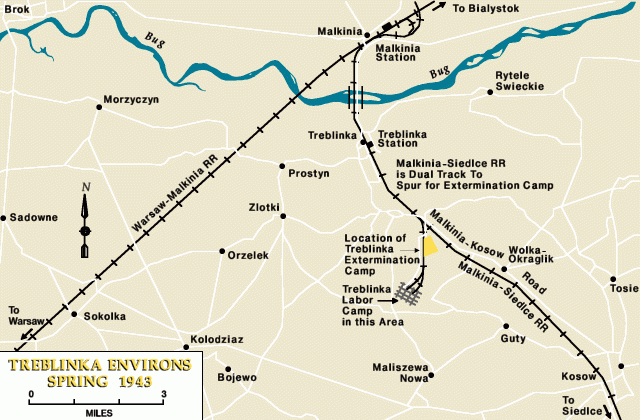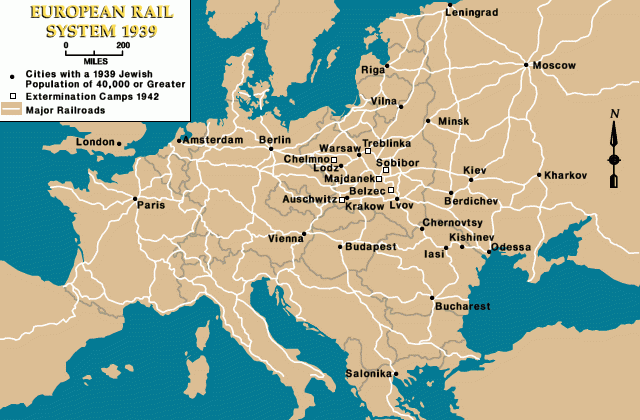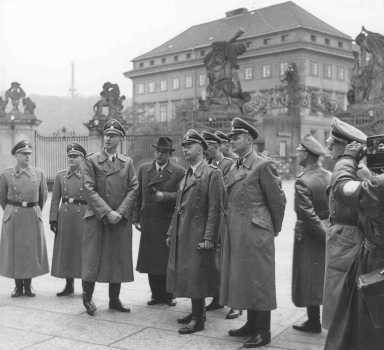
Reinhard Heydrich: In Depth
Reinhard Heydrich was one of the main architects of the “Final Solution.” He was chief of the Reich Security Main Office, the SS and police agency most directly concerned with implementing the Nazi plan to murder Jews of Europe during World War II.
Key Facts
-
1
At the Wannsee Conference on January 20, 1942, Heydrich presented plans, authorized by Adolf Hitler himself, to coordinate a European-wide “Final Solution of the Jewish Question.”
-
2
The British Special Operations Executive (SOE) organized the killing of Heydrich in Prague, where he was serving as the Deputy Reich Protector of Bohemia and Moravia. In a top-secret operation code-named “Operation Anthropoid,” the SOE trained a group of Czech resistance members to assassinate him.
-
3
Heydrich’s death after the assassination attempt led to reprisals against the Czech population, including the destruction of the town of Lidice and village of Ležáky.
SS General Reinhard Heydrich was chief of:
- The Security Service of the Reichsführer-SS (Sicherheitsdienst; SD) from 1931 until 1942.
- The German Secret State Police (Geheime Staatspolizei; Gestapo) from 1934 to 1936.
- The German Security Police (Sicherheitspolizei; SiPo), which consisted of the Gestapo and the criminal police detective forces (Kriminalpolizei; Kripo), from 1936 until 1942.
- The Reich Security Main Office (Reichssicherheitshauptamt; RSHA); after September 1939, the Security Police and SD were formally unified under Heydrich's command in the RSHA. The RSHA was the SS and police agency most directly concerned with implementing the Nazi plan to murder the European Jews during World War II.
While still chief of the RSHA, Heydrich served as Acting Reich Protector of the Protectorate of Bohemia and Moravia from 1941 until 1942.
Family History

Reinhard Heydrich was born on March 7, 1904, in Halle an der Saale, 20 miles northwest of Leipzig, in the German state of Saxony. He was baptized a Roman Catholic. His father, Bruno Heydrich, was an opera singer. He was the director of the music conservatory in Halle, which he had founded in 1901.
During World War I and its aftermath, Bruno Heydrich could barely keep the conservatory open due to economies imposed by the war. As his family struggled economically, Heydrich, still in his teens, was attracted to racist (völkisch) nationalism. He watched demonstrations, strikes, and street battles in Halle during the last year of the war and the revolutionary chaos that followed. Reinhard Heydrich earned his high school diploma in the spring of 1922. Instead of fulfilling his father's hopes that he would make a career in music (Heydrich was a gifted violinist), he enlisted in the German navy on March 30, 1922, less than a month after his 18th birthday.
As a naval officer, Heydrich specialized in signals and communications. He left the daughter of a senior naval officer to whom he had promised marriage for another woman, Lina von Osten, whom he would later marry. A military court of honor, scandalized by his disrespectful behavior during his hearing, found him to have dishonored the officer corps of the Reich Navy and compelled him to resign his commission in April 1931. His new bride was a fanatical National Socialist.
Creating a Nazi Party Intelligence Service
Heydrich was introduced to SS chief Heinrich Himmler in Munich by a family friend. At that time, Himmler was seeking to create an internal intelligence service for the Nazi Party. Himmler was so impressed by Heydrich's proposals that he brought him into the SS in August 1931 and tasked him with developing the Security Service (Sicherheitsdienst; SD). By January 1933, the SD under Heydrich's leadership had become the most significant intelligence agency within the Nazi Party. In June 1934, the party Deputy Chief Rudolf Hess named it the sole agency authorized to gather political intelligence inside the Third Reich.
Formation of the Reich Security Main Office (RSHA)
When Himmler was appointed commander of the Bavarian political police detective force on April 1, 1933, he appointed Heydrich his deputy. Himmler and Heydrich centralized the political police departments of Germany into the Gestapo. When Himmler's SS became independent of the SA after the purge of SA chief of staff Ernst Röhm and the top SA leadership on June 30-July 2, 1934, Heydrich took command of the Gestapo while remaining chief of the SD. Nine days after his appointment as Reichsführer SS and Chief of German Police on June 17, 1936, Himmler appointed Heydrich chief of the newly established Security Police Main Office (Hauptamt Sicherheitspolizei) which brought together into one agency the Gestapo and the Criminal Police detective forces.
From 1936 until 1939, Heydrich's formal title was “Chief of the Security Police and the SD.” After Nazi Germany unleashed World War II by invading Poland, Himmler formally linked the Security Police and SD by decreeing the establishment of the Reich Security Main Office (Reichssicherheitshauptamt; RSHA) on September 27, 1939, under Heydrich's command.
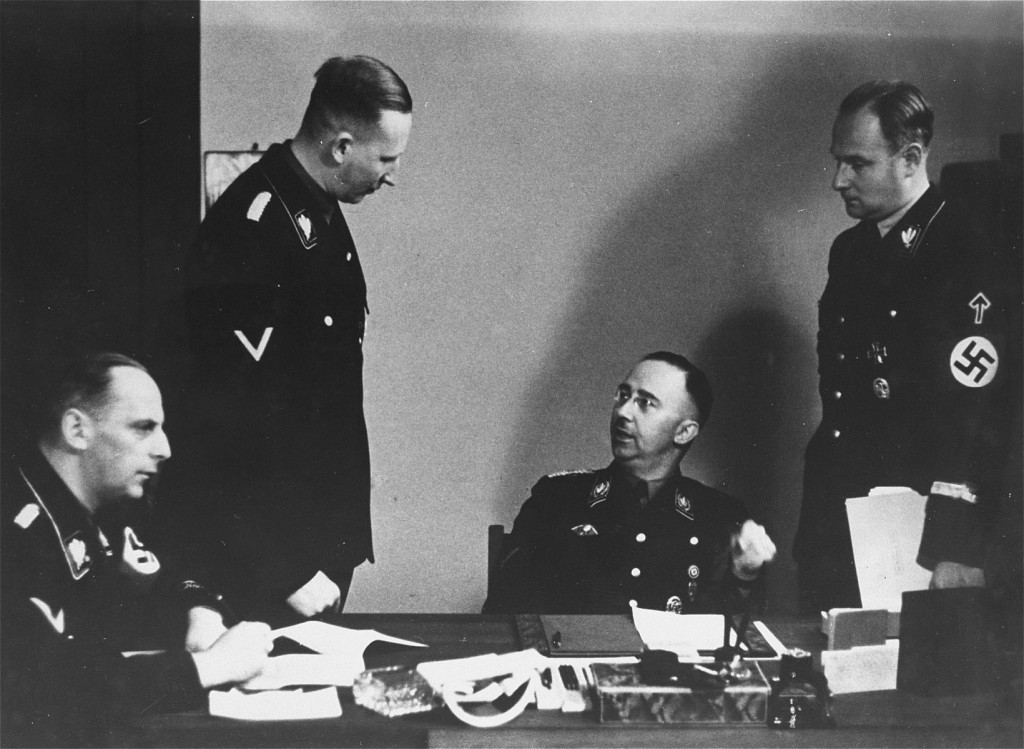
Suppressing Internal and External Enemies of the State
Under Heydrich, the Security Police and the SD was the primary agency responsible for intelligence analysis and executive measures in suppressing numerous internal and external enemies of the Nazi state.
The SD established intelligence departments to study the alleged long-term plots of each of the Reich's enemies:
- “World Jewry”
- “Marxists” (Communists, Social Democrats, and trade unionists)
- "political churches” (e.g. Lutherans and Catholic clergy who opposed the regime as well as members of other Protestant denominations—such as the Jehovah's Witnesses—whose members did not accept the authority of the Nazi state)
- right-wing nationalist opponents
- Freemasonry
The Gestapo arrested these political opponents and, where deemed appropriate, incarcerated them in concentration camps using the police authority granted by an order of Protective Custody (Schutzhaftbefehl).
The Kripo investigated so-called non-political criminal acts and behavior. Kripo officers arrested those whose alleged criminal or anti-social behavior was deemed dangerous to the Reich. In addition to persons with past criminal records, Kripo officials arrested homosexuals, Roma and Sinti (Gypsies), and people who engaged in whatever the Kripo deemed to be “asocial” behavior. Analogous to the Protective Arrest Order, the Kripo used a Protective Detention Order (Vorbeugungshaftbefehl) as the instrument of indefinite arrest and incarceration.
Heydrich and Himmler had a shared view both of the identity of the long-term enemies of the German race and of the measures to be taken against them. Like Himmler, Heydrich believed that the destruction of overt, “visible” opponents was not sufficient to guarantee the security and survival of the German race as the Nazis defined it. These "visible" opponents included:
- Communist and Social Democratic activists
- intellectual and organizational adherents of liberal democracy, traditional conservative nationalism, and Christian values
- Jews who held leading positions in the Marxist and liberal democratic movements in Germany and Austria as well as non-affiliated Jewish intellectuals who opposed the Nazi regime
These “visible” enemies, however, possessed international ties and aligned themselves with “camouflaged” enemies, who sought from within to destroy the “natural” bond between the Nazi leadership and the German people. As Heydrich explained in April 1936, racially conscious Germans must realize that
“effective struggle against the enemy must derive from recognition of the fact that all visible, apparent enemies are but the tip of the iceberg of eternal, unchanging dangerous spiritual forces.”
—Reinhard Heydrich
The enemies themselves were “eternally the same”: “the Jew, the Freemason, and the politically-oriented cleric.” The “invisible,” submerged, camouflaged ideological wellsprings of these “enemies” lay in the “infectious residue” of “Jewish, liberal and Freemasonic spirit,” modes of thinking (democracy, communism, Christian and liberal individualism) that were outgrowths of allegedly inherited racial characteristics. Only the complete destruction of the “biological sources” of such thinking would eliminate the danger presented by such influences.
Ultimately, “invisible” Jewish opponents were the Jewish people themselves—as the Nazis defined them—and those who “thought like Jews”: Communists, liberals, democrats, champions of minority rights, Freemasons, Christian clerics who opposed the regime, Soviet communists, and the US and British leadership classes who opposed the “natural” expansion of Nazi Germany. To be absolutely safe, the Nazis had to destroy the members of the so-called Jewish race, whose genetic makeup created the basis for such thinking, as well as the Slavic and Asiatic leadership classes, whose heredity incorporated a propensity to follow that Jewish leadership.
Heydrich developed some of these themes in his writings of the mid-1930s and used them to advocate Security Police and SD leadership in “solving the Jewish Question.” In 1938, SD “experts,” led by then SS First Lieutenant Adolf Eichmann, demonstrated imaginative leadership in “Jewish matters” (Judenangelegenheiten) by establishing a one-stop station in Vienna (Zentralstelle für jüdische Auswanderung). This office aimed to facilitate the forced emigration of Jews from Austria and to finance those operations by extorting funds from wealthier members of the community.
The SS and police both steered the violence of Kristallnacht (“Night of Crystal,” commonly known as “Night of Broken Glass”) directly and exclusively at Jews. In the wake of the pogrom they implemented the first roundup of Jews—nearly 30,000 —simply because they were Jewish. The SS and police incarcerated the victims of this first internal “deportation” in the hopes that a stay in concentration camp would accelerate the decision to emigrate and make leaving assets behind seem less significant.
Plans for a "Solution to the Jewish Question"
Impressed by Heydrich's dynamic leadership in the competition with officials of the Nazi Party and the German state for the leading role in “solving” the “Jewish Question,” Hermann Göring, the recognized deputy of Hitler in this matter, authorized Heydrich on January 24, 1939, to develop plans for a “solution to the Jewish Question” in the German Reich.
As Nazi Germany began military expansion, Heydrich created Operations Groups (Einsatzgruppen) of the Security Police and the SD. He tasked them with a variety of security duties:
- the seizure of key buildings and documentation
- the establishment of functioning intelligence operations
- the identification and elimination of real and perceived opponents of German rule
Einsatzkommandos (Operations Detachments) first went into Austria after the Anschluss in March 1938 and into the Sudetenland after its annexation in early October 1938. They secured documentation and intelligence information, and identified and arrested “enemies.”
When Germany invaded Poland in 1939, six Einsatzgruppen moved into Poland on the heels of the front-line troops and shot and/or identified persons they believed to be a danger, including thousands of members of the Polish nationalist and cultural elite. They also arranged to concentrate Poland's Jewish communities in large cities for “future removal.”
With the invasion of the Soviet Union on June 22, 1941, Nazi Germany embarked on a war against its arch-enemy in Europe: Soviet Communism. Heydrich believed that Soviet Jewry formed the “biological basis” for the Soviet state. Therefore, he gave explicit orders that the four Einsatzgruppen of the Security Police and SD that followed the German army into the Soviet Union physically annihilate Jews holding positions in the Soviet Communist party and the Soviet state apparatus. In actual practice—and perhaps in accordance with a pre-invasion verbal understanding—the Einsatzgruppen annihilated most Jews of arms-bearing age from the very first days of the invasion.
By the beginning of August, after identifying and concentrating the Jews in ghettos or holding centers, Einsatzgruppen personnel coordinated larger SS and police forces in operations to eliminate entire Jewish communities in the Soviet Union.
On July 31, 1941, Göring authorized Heydrich to coordinate the resources of the Reich “for a total solution of the Jewish Question in the area of German influence in Europe.” To this end, Heydrich was to submit a draft measures proposed “to implement the desired final solution of the Jewish Question.”
In the following six months, as regional Security Police and SD commanders coordinated the annihilation of the Soviet Jews, the first trainloads of German, Austrian, and Czech Jews rolled eastward to killing sites in the so-called Reich Commissariat Ostland (a German civilian occupation region that included the Baltic States and most of Belarus). Security Police and SD officials of RSHA department IV B 4 arranged for the roundups inside Germany with local police agencies and for the transport by train with officials of the Reich Ministry of Transportation and the German State Railroads (Deutsche Reichsbahn). Regional Security Police and SD commanders in Reich Commissariat Ostland commanded the operations to shoot them after their arrival.
Wannsee Conference
On January 20, 1942, Heydrich invited key officials from various Reich Ministries to a conference at a villa on the Wannsee, on the southwestern edge of Berlin. The ministries included the Foreign Ministry, the Ministries of Justice and the Interior, and civilian occupation officials in the Government General and the Reich Commissariat Ostland. At this Wannsee Conference Heydrich presented plans, authorized by Hitler himself, to coordinate a European-wide “Final Solution of the Jewish Question.” He informed the participants that Hitler had both authorized the physical annihilation of the European Jews and had designated the SS—specifically the RSHA under Heydrich—to coordinate “Final Solution policy.” He impressed upon them the need for active participation of their agencies to guarantee the ultimate success of the operation.
Even as Heydrich planned the elements of what would become the killing aspect of the Holocaust, he sought other areas in which to secure future SS predominance in Nazi Germany. Both Himmler and Heydrich aimed to demonstrate that the SS could administer territory both within and outside the Reich more effectively than civilian bureaucrats or military officers, whom they expected the SS elite to supplant after a German victory.
Resistance and Reprisal in Bohemia and Moravia
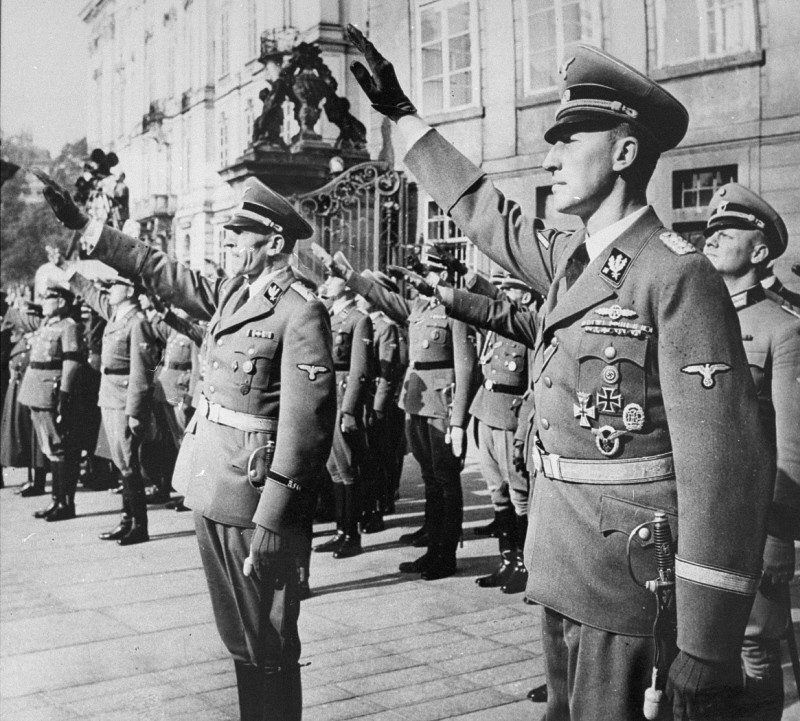
After the invasion of the Soviet Union spurred a previously dormant communist resistance movement in Bohemia and Moravia into acts of sabotage, Hitler dismissed Reich Protector Konstantin von Neurath and appointed Heydrich acting Reich Protector in September 1941. Heydrich first ordered a narrow wave of terror targeting real and perceived leaders of opposition in the Czech lands. In October and November 1941, Protectorate special courts sentenced 342 people to death and turned 1,289 “over to the Gestapo.” Heydrich also established the Theresienstadt camp-ghetto in November; under his rule, 14,000 German and Austrian Jews and more than 20,000 Czech Jews were deported from Theresienstadt to the Lodz ghetto, to the Government General, and to the Reich Commissariat Ostland.
Heydrich as acting Reich Protector then courted Czech industrial workers and farmers, whose productive capacity was necessary to the German war effort, with wages and benefits packages equivalent to those of their German counterparts. The result of his policies was a 73% reduction in acts of sabotage within six months. By spring of 1942, the German authorities could boast of a pacification of the Protectorate. Some have speculated that Heydrich aimed next to assume a newly created top civilian position in occupied Northern France and Belgium.
Assassination
Heydrich was so confident that his pacification program had succeeded that he flagrantly disregarded measures for his own security and traveled around Prague in an open vehicle. On May 27, 1942, as he traveled on a familiar route to the airport to fly to Hitler's headquarters, two Czech parachute agents succeeded in rolling a hand grenade under Heydrich's transport vehicle. Though not mortally wounded by the blast itself, the grenade splinters in his leg and lower back led to an infection that killed him on June 4, 1942.
Both Hitler and Himmler mourned this most ruthless implementer of the “Final Solution.” Hitler described Heydrich as
“one of the best National Socialists, one of the staunchest defenders of the concept of the German Reich and one of the greatest opponents of all enemies of this Reich.”
Himmler would later praise Heydrich's loyalty to the unified SS elite:
“…with all the ambition that he invested in his Security Police and his Reich Security Main Office, he saw all things first of all from the viewpoint of the entire SS.”
On June 9, the day of Heydrich's state funeral in Berlin, Hitler ordered retaliatory measures against the Czech population. Reprisals focused on the town of Lidice and another small Czech village, Ležáky.

Operation "Reinhard"
The RSHA that Heydrich created and the “Final Solution” policy that he initiated would be dreadfully effective after his death. The Germans and their Axis partners killed six million Jews between 1941 and 1945. SS and police leaders in occupied Poland would later rename an operation in “honor” of this most ruthless practitioner of mass murder: Operation Reinhard. Under Operation Reinhard, the SS and police murdered approximately 1.7 million Jews in three killing centers (Belzec, Sobibor, Treblinka) and in related shooting operations.
Critical Thinking Questions
What pressures and motivations affected Heydrich as he rose through the ranks to his leadership position? Were they specific to the Nazi worldview, or were they similar to factors which influence others, then and now?
Investigate other attendees at the Wannsee Conference and their roles.


